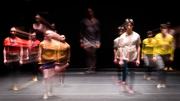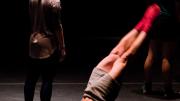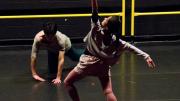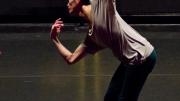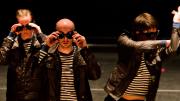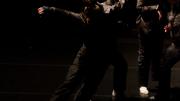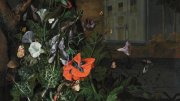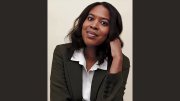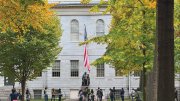In one scene, the pitch-black auditorium reverberates with the desolate sound of a droning sonar—and nothing else. In another, headphoned dancers wiggle onto the stage, gyrating their bodies to songs on their iPods, lost in their own worlds of music. In a third, off-stage doors slam as dancers march across an open floor, pausing one by one to shout out expressions such as, “Is this it?”
Last weekend’s trifecta of modern dance performances at Farkas Hall was indeed it. The Office for the Arts event marked dance director Jill Johnson’s biggest Harvard show since taking charge of the program last fall. A mix of emotion, passion, innovation, and ethereal movement, Spring Performances is the culmination of a five-week collaboration among Johnson, Dance Program artist-in-residence Christopher Roman, and more than 20 students. Comprising three separate works—The Sum of Missing Parts, Third Rail, and The Sound of Distance in Itself—the show drew upon poetry, design, architecture, and literary influences, all part of Johnson’s transdisciplinary approach to dance.
“It’s a lot about curiosity toward dance, curiosity about collaboration, a sort of openness,” said dancer Tim McCormack, G ’16, explaining Johnson’s teaching method. “It’s about practicing not knowing and being OK with it.”
The Sum of Missing Parts, co-choreographed by Roman and the 12 dancers in the piece, was an investigation both of composition and of the improvisation technologies developed by renowned choreographer William Forsythe. Individuals and pairs were showcased while the nondancing performers served as the “set” for the piece, creating an obstacle course of sorts for the featured dancers. Roman’s inspiration arose from conversations he had with his students about fear, as well as from the five dance combinations they learned during J-term.
“The dancers in this piece all come from very different backgrounds,” said Halimeda Glickman-Hoch ’12. “I’m from a very traditionalist ballet background, but we had people who are hip-hop dancers and everywhere in between. So much of it was being in the studio and playing around with movement together to really help us become a cohesive ensemble. Everyone got pushed and everyone really had their strengths played to. It was a really wonderful experience.”
Third Rail, co-choreographed by Johnson and Roman, investigated ideas of choreographic design. It features several performers with iPods strapped to their arms, dancing to the music they hear while taking turns holding their headphones up to a microphone to allow the audience to hear their own personal soundtracks for a few seconds. Calling it a bridge between The Sum of Missing Parts and The Sound of Distance in Itself, Johnson said the piece was meant to buck tradition: it began 10 minutes into the intermission, with all the houselights still on. “We wanted to sort of peel back what it’s like to see the inside of a process, so we changed the construct of how that piece was framed,” she explained.
The final work, The Sound of Distance in Itself, was a modern-dance portrayal of the Antarctic expeditions of British explorers Robert Scott and Ernest Shackelton. In darkness, six dancers clad in dark nylon jackets and goggles whipped metal tape measures to create the sound of whistling wind as Gavin Bryars’s “String Quartet No. 1” blared over the speakers. Later, the dancers laid their tape measures criss-cross on the stage floor as if they were cracks in the ice. The piece, co-choreographed by Johnson and the six participating student dancers, was the product of Johnson’s masterwork class—Music 103r—which studied how William Forsythe had tackled the same subject in his show One Flat Thing Reproduced.
Johnson, who was an original cast member of One Flat Thing, said she was surprised her Harvard students were able to create such a realistic ode to it: “Originally I didn’t expect that the expeditions would make it so clearly into the piece, but we started talking about what it would be like to map, and what it is like to be in a terrain that you haven’t yet explored, and be a team on that mission, so they did.”
In designing The Sound of Distance in Itself, inspired by a poem by Boylston professor of rhetoric and oratory Jorie Graham, Johnson focused her dance classes on topics such as architecture and design to broaden her students’ vision. “Architects compose spaces for people to interact with, so how is that similar to choreographic design?” she asked. “There are different approaches to making something. Architects may have a great idea, but maybe the materials aren’t readily available, or they have a budget constraint, or the idea isn’t structurally sound. I want [my students] to think the same thing about choreography. When you go to make something, is it structurally sound? If you have one idea and it’s not successful, how long do you stay with that idea in order to see it manifest?"
Johnson’s students are concentrating in various disciplines, including math, physics, biochemistry, and anthropology. (Harvard does not have a dance concentration.) That’s helped them to think outside the traditional boundaries of their art, just as Johnson encourages them to do. “My favorite part of her rehearsals and her process in general is the musicality, expression, and the asking of ‘How can we make this movement fuller?’ and ‘What is it?’” said Thuy Phan ’12. “We never know what ‘it’ is. It’s this ephemeral, ever-changing thing.”
